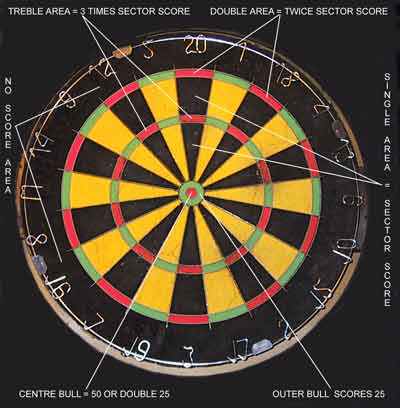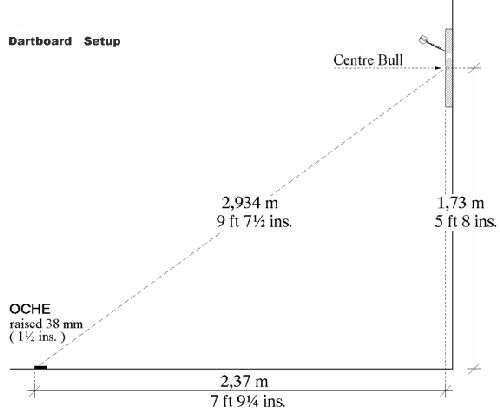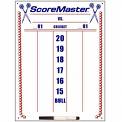The Rules Of Darts
The rules of darts are quite simple to follow and players should familiarise themselves with the rules end etiquette of the game. The Cyprus Darts Federation expects all players to be familiar with darts rules and to play matches or games in a sporting manner.
THE BASICS OF DARTS IN 7 EASY STEPS
STEP 1: KNOW THE DARTBOARD
THE BASICS OF DARTS IN 7 EASY STEPS
STEP 1: KNOW THE DARTBOARD
Figure 1: A standard dartboard

Figure 2: The official WDF Dartboard setup.

STEP 3: SELECTING A SET OF DARTS:
You should not rush into buying a set of darts. The weight and shape of darts varies enormously, as do the shapes of the flights. We recommend that you try as many different types of darts and flights as possible before making a purchase. After a while you will soon become aware that each different type of dart behaves differently when YOU throw it. Take your time, find a set that you feel comfortable with BEFORE you buy.
STEP 4: DARTS TERMINOLOGY:
Here is a brief glossary of some of the common and most used terms and phrases used in darts:
"Game on":-
Advises all players that the match has now started."Ochie"
(pronounced "okkey") :- The name of the throwing line."Leg shot":-
Signifies that a player has completed (Won) the "leg""Game shot":- Signifies that the match winning double has been hit.
"Bust":-
Means a player has scored more than the score required."Double in":- A double is required before scoring can commence.
"Straight start":-
No double required to start."Ton":- Means a score of 100 points or more.
"Ton-forty":-
Means a score of 140 points or more."Ton-eighty" or "Maximum":- Means a score of 180 points.
STEP 5: THE BASICS OF A GAME OF DARTS.
A game of darts always starts, and ends, with a handshake.
A game of darts can be played in played in several forms. The most common forms are:- One player against another which is known as "Singles" or teams of two players per team which is known as "Doubles" or "Pairs". A game of darts is played over an agreed number of sections which are known as "legs". The number of "legs" in a game is always an odd number usually 1, 3, 5, or 7 "legs". Matches are played as (for example) "Best of 5 "legs". This means that the first player or team to win 3 "legs" win the match.
Players throw alternately in "Singles" matches. In "Doubles" or "Pairs" matches each "Pair" throws alternately with each player in the respective "Pair" also throwing alternately. A "Throw" consists of "3" darts. If a player completes the "Leg" or the match in less than three darts the remaining dart or darts are not thrown.
Matches usually start from 501 in competition darts but other common starts are 301, 401, 701, and even 1001. Sometimes darts matches are played where a "double" is required to start each "Leg" of the match. However, the most common form of play is "straight start" which means that players/teams can begin to score points immediately with the first dart thrown.
Both teams start on the agreed starting number and the object is to score down to zero as quickly as possible. The value of the different sectors of the dartboard can be seen in Fig 1. above. Each section or "leg" of the match must be finished with a "double", this means the outer scoring ring. For example as one approaches the end of a "leg" a player or team may have 40 points left to score.
This means Double 20 is required and to end the "Leg" a dart must be thrown into the "double" section of the "20" sector. Should the thrower miss "double" 20 and hit (for example) a single 1, the the thrower would require 39 to win the "leg" where a single 7 then "double" 16 could be an option. Another example could be the player or team require 51 points. Then there would be several alternatives to end the "leg".
The usual route would be either a single 11 and then "double" 20, or perhaps a single 19 and then "double" 16. The first player or team to hit the required "double" wins the "leg". A new leg is then started and the procedure repeated until one of the players or teams has won the required number of "legs" to win the match.
STEP 6: HOW TO KEEP SCORE.
The scoreboard starts as a blank sheet of paper which is usually hung on the wall about 50 cm or 1.5 feet to the left of the dartboard and at about the same height as the dartboard itself. The picture below shows how a scoreboard usually looks but you can use paper or a blackboard. You usually start with a score of 501 and deduct your score until you reach 0 by finishing on a double.

STEP 7: LEARN THE RULES PROPERLY
This has been a very simplified introduction into the game of Darts. Your next step should be a look at the the complete rules for Tournament Darts. Here you will find all you need to know about the rules of darts. The rules can be found in the main menu on the opening page of this website.
ADDITIONAL INFO: LEARN HOW TO FINISH
Once you have got the hang of things its time to start learning how to finish your "legs" and matches in the quickest possible way. There are many, many ways to "finish". See Parts Darts for more information and help.